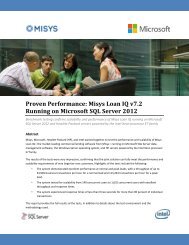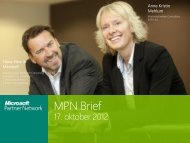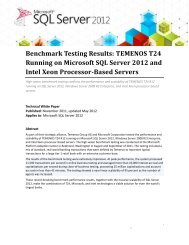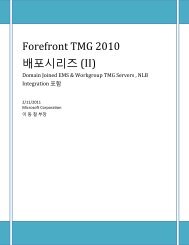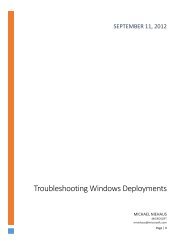Best Practices for Running Dassault Systèmes ENOVIA ... - Microsoft
Best Practices for Running Dassault Systèmes ENOVIA ... - Microsoft
Best Practices for Running Dassault Systèmes ENOVIA ... - Microsoft
Create successful ePaper yourself
Turn your PDF publications into a flip-book with our unique Google optimized e-Paper software.
Database file or filegroup backup. Contains only data from specified file(s) orfilegroups(s) to allow quick, piecemeal restores if only part of the database is lost. Thesetypes of backup are not recommended <strong>for</strong> <strong>ENOVIA</strong> deployments.The different types of backup let you back up with the frequency appropriate to your businessrequirements, even if your databases are very large. A typical backup strategy <strong>for</strong> a largedatabase (<strong>for</strong> example, several hundred gigabytes) might include a weekly full backup, nightlydifferential backups, and transaction log backups every 30 minutes.If the database was lost, the DBA would:1. Per<strong>for</strong>m a log backup if the log file is still accessible (this is referred to as a “tail of thelog” backup).2. Restore the last full backup.3. Restore the last differential backup.4. Restore all the transaction log backups since the last differential backup, in sequence.If properly executed, this returns the database to operation with at most 30 minutes of worklost.For small databases, it is perfectly valid to simply per<strong>for</strong>m full backups once a day or even morefrequently. This approach is simple, but is practical only <strong>for</strong> databases that can be backed upvery quickly.It is important to remember that <strong>for</strong> databases using the full or bulk-logged recovery model,regular transaction log backups are required to keep the log from growing out of control.The right backup strategy depends on the database size and level of change activity in yourinstallation. This can vary greatly, even across deployments of <strong>ENOVIA</strong>, so there is no “one-sizefits-all”recommendation. However, keep the following in mind as you plan your backupstrategy:If you choose the full recovery model, the transaction log can grow very quickly andshould be scheduled <strong>for</strong> backup at multiple times throughout the day. Per<strong>for</strong>mingmultiple backups ensures that the log is truncated frequently and provides <strong>for</strong> improveddata recoverability.If you choose the simple recovery model, schedule full database backups <strong>for</strong> at leastonce per day. With this method, data recoverability is limited to the last full databasebackup.Database backups should be stored off site when possible and appropriate.Back up a database immediately after you make extensive changes or per<strong>for</strong>m nonloggedoperations.31



